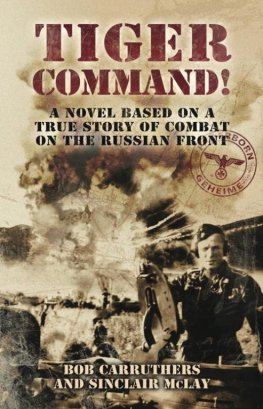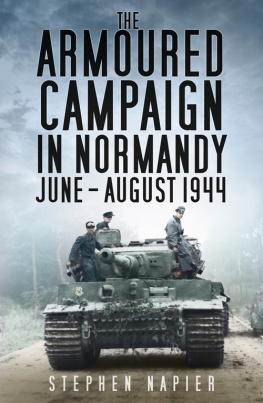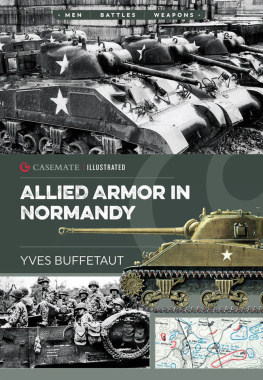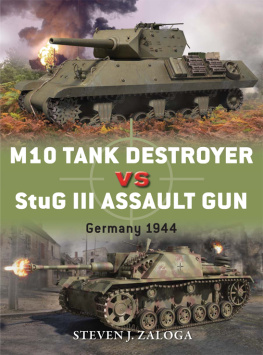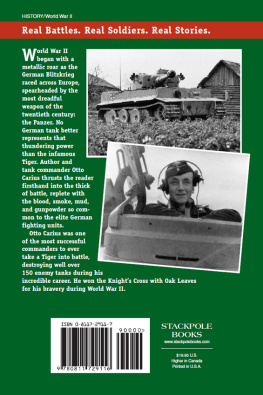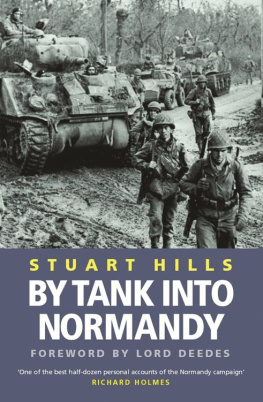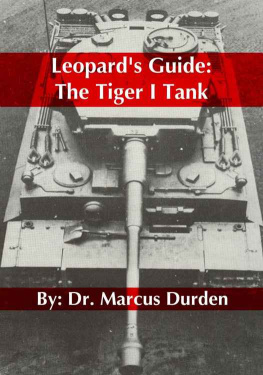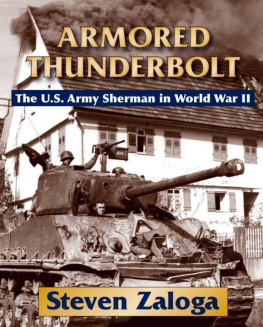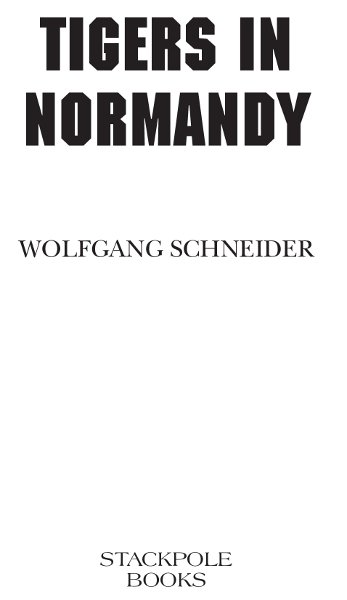
English translation 2011 by Battle Born Books and Consulting
Published in 2011 by STACKPOLE BOOKS
5067 Ritter Road
Mechanicsburg, PA 17055
www.stackpolebooks.com
Originally published in German in 2004 as Tiger im Kampf: Die Einstze in der Normandie. All rights reserved, including the right to reproduce this book or portions thereof in any form or by any means, electronic or mechanical, including photocopying, recording, or by any information storage and retrieval system, without permission in writing from the publisher.
Printed in the United States of America
10 9 8 7 6 5 4 3 2 1
Library of Congress Cataloging-in-Publication Data
Schneider, Wolfgang, Oberleutnant.
[Tiger im Kampf. English]
Tigers in Normandy / Wolfgang Schneider.
p. cm.
Includes .
ISBN 978-0-8117-1029-9
1. World War, 19391945CampaignsFranceNormandy. 2. World War, 19391945Tank warfare. 3. Tiger (Tank) I. Title.
D756.5.N6S3713 2011
940.54'21421dc23
2011027976
eBook ISBN: 9780811745093
Contents
Foreword
T he two-volume series entitled Tigers in Combat, encompassing nearly 1,000 pages, has presented a nearly seamless overview of the fate of all of the armored formations equipped with the Tiger. It goes without saying that this could only be accomplished by using an abbreviated style that was reminiscent of that used in military daily logs.
The desire for a more comprehensive treatment has been voiced. This has been accomplished in a number of battalion historiesschwere Panzer-Abteilung 503, schwere Panzer-Abteilung 507, schwere Panzer-Abteilung 508 and schwere SS-Panzer-Abteilung 101 come to mindbut the first detailed analysis of a combat area of operations from the viewpoint of Tiger operations is to be found here.
The 60th anniversary of the Allied landings in Normandy in June 1944 provided the impetus for this effort. When one looks at the literature and evaluates the sources, one gains the impression that the Tiger must have played a decisive role in those combat operations. Both British and Canadian accounts create that impression, inasmuch as they continually reference how much that particular model of tank caused shock and fear.
The tanks debut in Normandy at Villers-Bocage on 13 June 1944 was a spectacular one and has been the subject of many accounts.
This book will determine whether these claims accurately reflected reality and the Tiger actually played such a significant role. In the face of an oppressive numerical superiorityespecially in the airand the small numbers of Tigers employed, doubts seem in order.
All of the engagements are analyzed with the help of accounts from both sidesGerman and Alliedso that it is possible to provide comparisons. In tank-versus-tank engagements, the Tigers had no competitors on the Western Allied side at that point in the war, but the Tiger crews had a number of demands placed on them that ultimately affected combat effectiveness.

Some of the unique characteristics of the terrain also played a major role. For that reason, numerous current images of the battlefields have been added, as well as detailed maps. Therefore, this book also functions as a battlefield guide. It is hoped that the reader will be encouraged to visit these locations himself. On each of the current terrain photos, the cardinal direction of the compass is indicated for the direction in which the viewer is oriented, e.g., N = north. Furthermore, for every major area of operation of the Tiger battalions, a sketch map is provided that shows these differing perspectives from a birds-eye view.

This degree of detail is only possible through the assistance of competent historians whose research in the recent past has been extraordinary in tracing the developments of the fighting. In this regard, Henri Marie, Bruno Renoult and Philippe Wirton deserve special mention, since their work is worthy of the highest praise. It was primarily through their help that it was possible to determine and verify the individual fate and final location of almost all of the tanks.

The accounts provided by individual soldiers have intentionally not been edited and, as a result, reflect personal sensitivities and viewpoints.

It has not been simple to find contemporary photographs, since the holdings in the available archives are small and almost all of the images are already well known. During the last few weeks of operations, there are generally only images of abandoned tanks. In addition, the quality of those photographs often leaves much to be desired. One exception was the photographs provided by Gotthold Wunderlich, a former member of the battalion, who provided the images of the 3./schwere Panzer-Abteilung 503 at Camp Mailly and in Paris.

In addition to the previously mentioned individuals, I would like to thank Thorsten Brandt for the production of the situation maps, my daughter, Kristine, for the design of the cover (German edition) and my family for their patience.
Chapter 1
Movement of the Tiger Formations to Normandy
Introduction
The formations equipped with the Tiger armored fighting vehicle have found special mention in the literature that comes from the side of the former Allies concerning the fighting in Normandy in the summer of 1944. A considerable amount of successful German defensive efforts in the course of the exhaustive fighting to break out of the beachhead are ascribed to these formations. Many firsthand accounts mention the superiority in battle of these tanks or the constant panic that was unleashed by them on the Allied side.
Up to this point, there has been no substantiated analysis of whether these claims accurately reflected reality or whether the Tiger actually played such a significant role. What is uncontested is the fact that in a tank-versus-tank engagement, it was greatly superior to all opposing tanks thanks to its superior armament and its superior ballistic protection. Did this superiority carry over to the tactical and operational levels, however?
This question will be examined in the following book. The operations in which Tiger tanks participated will be portrayed as well as their direct influence on the subsequent outcome. It will quickly become clear to the reader that there has been a series of incorrect interpretations in the available literature up to this point. Likewise, he will also receive a number of new and interesting insights.
While all of this will lead to a conclusion on the part of the author, which, in the end, is subjective, it is also intended to invite further discussion.
In order to keep this book within manageable proportions, it will be assumed that the reader is already familiar with a number of facts. This is particularly true with regard to the overall strategic framework. This is quite important, since the Tiger was never at any time omnipresent on the battlefield. Initially, it was only used against the British and Canadian forces in the greater area of Caen. Even thenas will be demonstratedit was only employed in certain areas.
Next page


